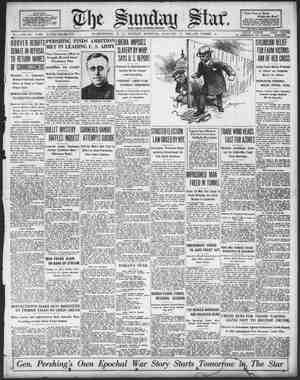Evening Star Newspaper, January 11, 1931, Page 78
You have reached the hourly page view limit. Unlock higher limit to our entire archive!
Subscribers enjoy higher page view limit, downloads, and exclusive features.
e et THE SUNDAY STAR, WASHINGTON, D. C, JANUARY 11, 1931, United States Marines firing on the “Know Nothings” and “Plug Uglies” in the election riot of June 1, 1857, at Seventh street and New York avenue, in which six were killed and 20 wounded. 0ld Landmark Once Stood on Site of Public Library—Tragic Deaths Connected With Its History—ZElection Riots of 1857, When Marines Were Called to Restore Order. BY JOHN CLAGETT PROCTOR. HE writer visited the Center Market on New Year eve—the last day this was open to the public. Some of the stands had already been deserted, while at others the mer- chants were busily packing up and preparing to make their departure. To the market peo- ple the real crisis had come, for here angd theré was even to be seen a stall or two that had’ already been dismantled by its former tenant, who had either moved elsewhere or perhaps gone out of business entirely. There were few happy faces to be seen. gravity of the situation had dawned upon Even the writer's big jovial friend, Mr. muller, in the south center of the smiled in only a businesslike He, too, he said, was wending Northern Liberty Market, at Fifth and , where many of the merchants businéss anew after January 1. Everywhere there seemed to what other than s L teenth and K sireets, was many years located in the Government triangular space on the north side of Pennsylvania avenue between Twentieth apd Twenty-first streets northwest, where it was opened on December 3, 1802, However, as time advanced, and the west end began to build up and grow, these nondescript e an eyesore, and it was deemed best to remove them, which was done in 1855, stands today is needed for public bufldings to make more attractive the Capital City, for ‘which we all have, or should have, even a sacrificing veneFation if necessary. Though, as indicated, the Western Market was not in the same class with the “Marsh Market,” yet it must have been a building of some proportions, for we find that in 1822 & considerable addition was made to it, which included the plading of a “commodious and useful room” as a second story. . On the Twentieth street side of the building the Union Engine House had its headquarters, and gave protection to the War and Navy bulldings. A room was also provided in this old building for public and private meetings, and many of the early questions and disputes arising in the flrs't ward were settled here. MR. ALBION K. PARRIS, who passed away & few months ago while on a visit to Canada, speaks of the Western Market in his paper read before the Columbia Historical Society on “The Frst Ward in the Early Sixties.” Of course, in his story, Mr. Parris necessarily largely refers to the new building at K and Nineteenth streets, but nevertheless his story is none the Jess interestings. He says: “In speaking of places and people, the Western or K Street Market must not be forgotten. n groceries and provision stores were hardly vogue in the sixties. Hence for real market~ ing all the family heads directed their steps marketward with regularity. The market was Jocated near the center of K street, between Twentieth and Twenty-first streets, in proximity #0 the present cne. If it cannot be said that business was rushing, it was at least satisfac- tory. #” r, Yeabower, Geolge Linkins and jolly Joe Weaver, with white aprons, were punc- tual in attendance and polite in their service. Never were there more satisfactory cuts of home-killed beef, lamb and pork than those dis- ‘worthies.’ - They “Joe Carroll and Mr. Huff (the latter is still Hving) were the dispensers of butter, eggs and cheese, while at the bread, pie and cake stall, conducted by George Krafft, the First Ward baker, Eighteenth and Pennsylvania avenue, one was generally waited on by black-eyed, smiling Miss Anna, a relative of Mr. Krafft. Then, too, old man Miller, who possessed a small truck farm at Twenty-first street and Massachusetts avenue, and Red-headed Miller (to distinguish him from the old man) were the purveyors of the best of fresh vegetables, “The country people, white and black, lined the sidewalk with their old broken wagons and decrepit mules stationed nearby. The colored folk displayed all kinds of herbs and roots guaranteed to cure any ailment and kill bugs and roaches at the same time, all for a dime. “There were no limousines or flivvers in those days to transport the opulent to the market. What was termed a ‘carry-all,’ or buggy, served the purpose for those owning them. So well do I recollect a member of the most prominent banking firm in Washington, footing it regularly from his residence near Seventeenth street to this market, his basket in hand and, stringing on behind, the several small daughters, each with a diminutive market basket. People in those days were certainly more independent ot neighborhood criticism in the doing of small, sensible things than in this day.” And so, in 1872, when he wanted to tear part of the unauthorized tracks of the more & Ohio Railroad, ewhich extended fi the Long.Bridge at the southern terminus Maryland avenue, along that avenue to First street, west, then to Indiana avenue, and thence to the Baltimore & Ohio Railroad Station, then located at New Jersey avenue and C street northwest, he simply laid his plans and saw to it that they were executed. Shepherd had given notice of his intention to John W. Garrett, the then president of the road, who as usual regarded it as a ‘“‘mere scrap of paper.” But the former was not to be site 2 the Northern Liberty Markes, 187 FRed of
